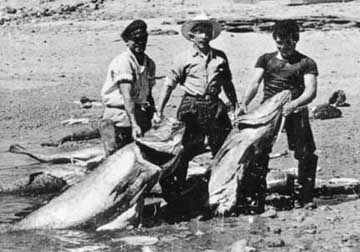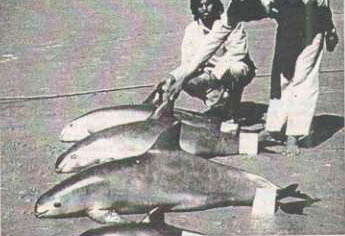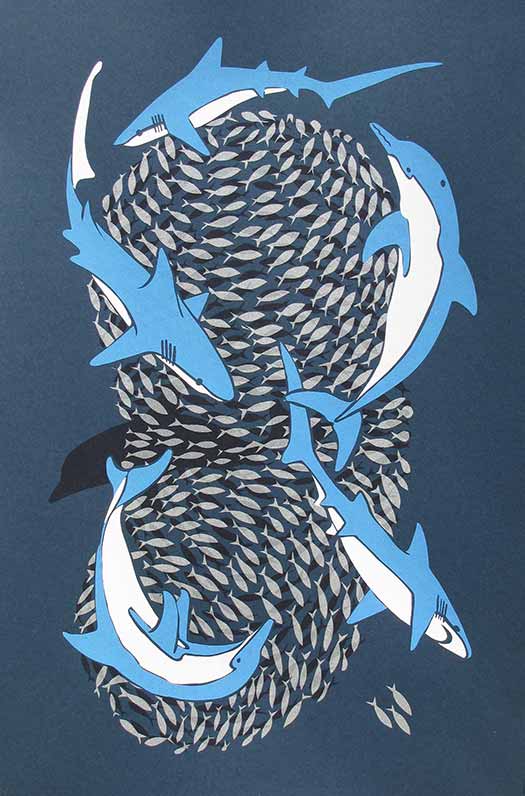
It’s been a while since I’ve posted any depressing stories about doomed animal life on this blog. Now that I’ve actually gone through with the whole moving-to-portland, thing, maybe I’ll get back on the ball with it. The last posting in this category was related to the crashing hammerhead shark populations in the Gulf of California, and I said at the time that the next entry would have to do with the terrible story of the Totoaba, a member of the croaker or drum family, that once spawned in incredible profusion at the northernmost tip of the Gulf, and in addition reached sizes of up to six and a half feet and 330 pounds. Alas, this is no longer the case. Read on for a truly spectacular tale of human destructiveness and asininity.
The Totoaba spawns exclusively in the turbid waters of the Colorado river estuary, at the northernmost tip of the Gulf. The fish migrates about a third of the way down the length of the gulf, on both the mainland and peninsular sides, before returning to the mouth of the Colorado to spawn. This limited range means that at spawning time, the entire population of adult Totoaba will be within a circle with a 300 mile diameter.
A fishery for the gigantic fish began around the turn of the century, and accelerated so swiftly that by the twenties Totoaba had already been commercially depleted near fishing towns such as Guaymas. Fisherpeople moved north, towards the Colorado, to the source of the fish. During these early years, exploitation of the Totoaba wasn’t about meat at all. The massive fish were dragged onto the beach, slit open, and their air bladders were removed. These bladders, known locally as buche, were baled together by the thousand and shipped off to China via San Francisco where they formed the base of a type of soup stock. The carcasses of the Totoaba were piled together on the beaches and left to rot. When the stench and flies became too intense, the fisherpeople would simply move down the beach away from the towering hummocks of putrefying fish.

A market for the Totoaba’s meat began to develop in the 20’s after US sportfishermen reported about the heaps of wasted meat on Gulf beaches. Commercial fishing developed into a profitable industry that lasted approximately twenty years, until the fish populations entered their predictably catastrophic decline. By the mid fifties, fleets of gill-netters had almost completely obstructed the Totoaba’s migratory pathway. People had also started fishing using dynamite.
Totoaba were granted official protection by the Mexican government in 1974, and in 1975 the trade in buche was prohibited by CITES, the international treaty on the trafficking in endangered species. The damage, however, was done. The Totoaba no longer spawned in massive numbers, and today it’s a good day if you see one that’s seventy pounds in weight. A thriving illegal fishing industry still takes a significant percentage of the Totoaba population every year, serving a thriving black market trade for both air bladders and meat, which is sold as white bass.
The insane devastation left behind by the decades of gillnetting includes another victim: the Vaquita. The Vaquita is the world’s smallest porpoise, to only five feet in length, and they live only in the Colorado river delta region, never venturing further afield. Never common, they spent the early part of the last century drowning in gillnets and the later part suffocating in the hypersaline sludge that currently passes for Colorado river outflow, after the vast majority has been used to irrigate deserts and grow things like cotton and tomatoes. There’s about 400 vaquitas left, and more are going every year.

So, to this litany of human assholery, greed, cunning, guile, and profligate gluttony, let’s add some contemporary musings… Where should we focus? Perhaps the plan to build a “boat-transporter” across the Baja peninsula to save wealthy sportfishers all that incovenient sailing around the southern tip stuff….maybe the rampant overdevelopment of condos, timeshares and other recreational claptrap that sucks up water and pumps out raw sewage, and has infected the Gulf shores like a raft of boils? The Miamification of large portions of the northern Baja peninsula by the manic laundering of drug money through gaudy hotels and clubs? Or the fact that the lab at the Autonomous University of Baja California, the only place in the world where totoaba are being bred, occasionally goes years without funding? No, wait, it’s got to be the fact that up until recently the incredible bounty of the Gulf was being pitchforked out of the sea to serve as fertilizer? (Settlers used to do that with salmon in the valley bottoms of the Pacaific Northwest) Pick one.
Then again, you might consider the plight of the Cucapa and Kiliwa peoples of the upper gulf region. These tiny indigenous groups have been squeezed off their land by the creation of a biosphere reserve designed to protect the vaquita and the totoaba, a project sponsored by Conservation International and the WWF. The Kiliwa at one point were considering a “death pact” to wipe themselves out before they were removed.
There was a single anomalous report of Totoaba, some gravid with eggs, caught near the southernmost tip of the Peninsula in 2004, fairly well documented and as yet unexplained. The director of the Totoaba lab at the Autonomous University at Baja California hypothesized that the fish were finding the turbid conditions they needed for spawning at underwater spring outflows. Unlikely? Perhaps. At this point in the life of this fish species, any news is good news.








A lot of people are so cruel to animals. They don’t know what they’re doing is hurting the environment.Please let us save the environment coz global warming is happening now.
Great article and historical photos. The historical shots are important, not only from a historical perspective, but also a scientific one. Many places around the earth have lost much of it’s once abundant biodiversity. In the Mediterraean recently a documentary of a young man growing up wanting to be a Marine Biologist as a result of watching those famous Jacque Cousteau documentaries actually went to waters off France and Italy where Cousteau filmed abundant masses of underwater sea life. Those same identical reefs today are mostly devoid of life with the exception od some tiny fish. All the large sized fish life is totally gone.
It was sad to listen to this young man reveal that now if he wants to study Marine Biology, he must do so ONLY by watching old documentary films as these.
You wrote this piece in 2009 and no one has commented. What does that tell you about the apathetic response of most people today on the environment ?
–Thanks again for this post
–
Thanks for your thoughtful response. I’ve heard about those reefs. Have a look at this excellent article on Mongabay about shifting baselines- a concept that goes a long way to explain why we have such a hard time relating to environmental disaster: http://news.mongabay.com/2009/0623-hance_shiftingbaselines.html#
Can you please share the source of the report of Totoaba, some gravid with eggs, caught near the southernmost tip of the Peninsula in 2004, fairly well documented and as yet unexplained. The director of the Totoaba lab at the Autonomous University at Baja California?
I’m not familiar with that report, but certainly curious if you were to find it.
Great article, but fails to mention anther ecocide performed on the Totoaba and the Sea of Cortez in general; that of the damming of the Colorado River and the cessation of all freshwater input to its estuary. For a review please refer to: Lercari y E. A. Chávez. “Possible causes related to historic stock depletion of the totoaba, Totoaba macdonaldi (Perciformes: Sciaenidae), endemic to the Gulf of California”. Fisheries Research, vol. 86, (2007): 136-142.
Thanks very much for that reference- yes, of course it is true that one of the most significant impacts on the gulf is the total diversion of the Colorado for agricultural and urban use in the US.
Thanks for your answer. The report is mentioned at the end of your article: “There was a single anomalous report of Totoaba, some gravid with eggs, caught near the southernmost tip of the Peninsula in 2004, fairly well documented and as yet unexplained. The director of the Totoaba lab at the Autonomous University at Baja California hypothesized that the fish were finding the turbid conditions they needed for spawning at underwater spring outflows”.I was wondering if you could provide me any more details and/or the source of the information. Thanks and best regards,
HI Lorenzo- I wrote this blog post in 2009, and I can’t find the sources I used to write it- most of it was produced through internet searches for information on totoaba natural history, however. I will do a little digging around and see what I can come up with.
Lorenzo, I found the article about the anomalous Totoaba sighting- sorry for confusion!
http://www.mexfish.com/ecap/ecap/ecaptoto/ecaptoto.htm
I found the article about the anomalous Totoaba sighting- sorry for confusion!
http://www.mexfish.com/ecap/ecap/ecaptoto/ecaptoto.htm